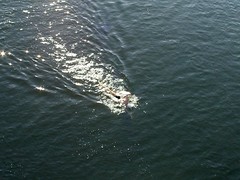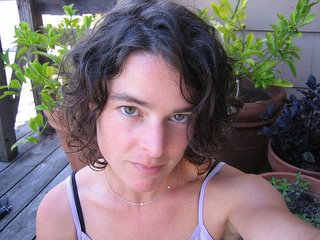one hundred and forty-seven
Since Mychal arrived, I've more or less put the camera away. This is true of this trip, and of my life in general. I'm a singularly bad photographer; I'm not sure if it's a question of patience or skill, but I suspect I simply lack the native talent for photographs. Luckily, Mychal more than compensates; not only is he good at it, he also truly enjoys it. (and lucky me: swap out photography for any number of words: cooking, decorating, designing, shopping....)
Sitting across from me, camera and beer at hand, Mychal's transferring them to his computer: all 147 of them. And today wasn't such a big day.
Today we set off for the cemetery on the dvoika (#2) tramway. This route got us in the general vicinity of the cemetery, which was good enough for me. I'd calculated on getting off a stop before the street we needed, but we ended up getting off a stop after. The mistake was fortuitous, as it took us a big, snowy park; we walked up a snow-packed path, past the circle of tracks for the tramway turnaround, and around a corner into a fenced cemetery. Not the one we'd been aiming for, but one which was perched on a hill giving us a view of most of the city: the downtown, several of the churches we've been into or walked past, even the electrical tower near our building. The walled cemetery also looked over a stadium, bleachers on the southern half; just under the cemetery, a flat piece of ground littered with bottles formed impromptu seating on the northern side. A lone set of footprints carved out a path in the snow covered track, a solitary figure stretched over a hurdle.
We walked downhill through the snowy Pasichka Park, reaching a small street bordered on one side with (what appeared to be) single family homes and on the other another stadium and track. Of all the luck: two tracks within minutes of each other! There was an earth mover stationed at one end of this track; nearby, a small patch of concrete behind the goal had been cleared out, and a group of men, some shirtless, played soccer. Axel watched the game over my shoulder, I tried not to resent the snow on the track. There were no bleachers at this stadium, but the sides were terraced. We walked along the top ridge, sloping down the hill towards a small green gate just past the stadium. From here, we could see the rear gate to the Lichakivs'ke Cemetery--a dilapidated concrete arch housed locked iron gates, a small door to the left. More snowy paths, concrete and marble grave markers, plastic wreaths and colored glass lanterns. Simultaneously, the cemetery gave off the appearance of neglect and care: crumbling grave stones, fallen trees, snow-laden grasses and plastic flowers were accompanied by small wooden benches, bouquets of fresh flowers, and thousands upon thousands of footprints through the snow.
Axel wanted to know about the little houses, and I described the people lying within, waiting patiently for their relatives' visits. They are waiting here? he asked, pointing to another grave. And this is a grave too? He noticed the candles and lanterns, the etched faces and names, and, hidden to me, a small dog. I began to read the names, searching for something resembling my grandfather's; though I knew this was a Christian cemetery, I couldn't help but look. Russian, Ukrainian, Polish and German names lay next to one another; some stones had Polish on one side and, in cyrillic, Ukrainian or Russian on the other. We arrived at the entry-way to the cemetery, a grand affair with mausoleums of famous people. But we were tired and hungry, ready to sit on the tramway headed for home.
Sitting across from me, camera and beer at hand, Mychal's transferring them to his computer: all 147 of them. And today wasn't such a big day.
Today we set off for the cemetery on the dvoika (#2) tramway. This route got us in the general vicinity of the cemetery, which was good enough for me. I'd calculated on getting off a stop before the street we needed, but we ended up getting off a stop after. The mistake was fortuitous, as it took us a big, snowy park; we walked up a snow-packed path, past the circle of tracks for the tramway turnaround, and around a corner into a fenced cemetery. Not the one we'd been aiming for, but one which was perched on a hill giving us a view of most of the city: the downtown, several of the churches we've been into or walked past, even the electrical tower near our building. The walled cemetery also looked over a stadium, bleachers on the southern half; just under the cemetery, a flat piece of ground littered with bottles formed impromptu seating on the northern side. A lone set of footprints carved out a path in the snow covered track, a solitary figure stretched over a hurdle.
We walked downhill through the snowy Pasichka Park, reaching a small street bordered on one side with (what appeared to be) single family homes and on the other another stadium and track. Of all the luck: two tracks within minutes of each other! There was an earth mover stationed at one end of this track; nearby, a small patch of concrete behind the goal had been cleared out, and a group of men, some shirtless, played soccer. Axel watched the game over my shoulder, I tried not to resent the snow on the track. There were no bleachers at this stadium, but the sides were terraced. We walked along the top ridge, sloping down the hill towards a small green gate just past the stadium. From here, we could see the rear gate to the Lichakivs'ke Cemetery--a dilapidated concrete arch housed locked iron gates, a small door to the left. More snowy paths, concrete and marble grave markers, plastic wreaths and colored glass lanterns. Simultaneously, the cemetery gave off the appearance of neglect and care: crumbling grave stones, fallen trees, snow-laden grasses and plastic flowers were accompanied by small wooden benches, bouquets of fresh flowers, and thousands upon thousands of footprints through the snow.
Axel wanted to know about the little houses, and I described the people lying within, waiting patiently for their relatives' visits. They are waiting here? he asked, pointing to another grave. And this is a grave too? He noticed the candles and lanterns, the etched faces and names, and, hidden to me, a small dog. I began to read the names, searching for something resembling my grandfather's; though I knew this was a Christian cemetery, I couldn't help but look. Russian, Ukrainian, Polish and German names lay next to one another; some stones had Polish on one side and, in cyrillic, Ukrainian or Russian on the other. We arrived at the entry-way to the cemetery, a grand affair with mausoleums of famous people. But we were tired and hungry, ready to sit on the tramway headed for home.




0 Comments:
Post a Comment
<< Home